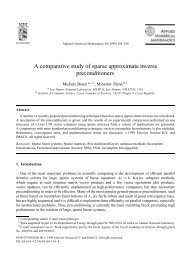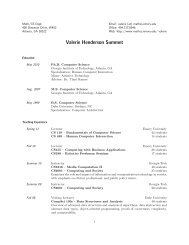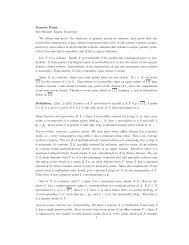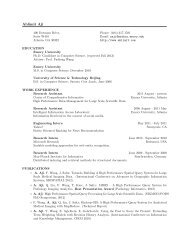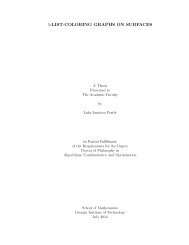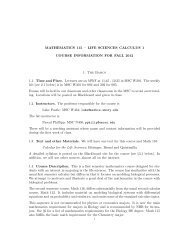Chapter 3 Solution of Linear Systems - Math/CS
Chapter 3 Solution of Linear Systems - Math/CS
Chapter 3 Solution of Linear Systems - Math/CS
Create successful ePaper yourself
Turn your PDF publications into a flip-book with our unique Google optimized e-Paper software.
48 CHAPTER 3. SOLUTION OF LINEAR SYSTEMS<br />
(a)<br />
(b)<br />
(c)<br />
(−1)x1 + 0x2 + 0x3 = −1<br />
0x1 + 3x2 + 0x3 = 6<br />
0x1 + 0x2 + (−5)x3 = −15<br />
(−1)x1 + 0x2 + 0x3 = −1<br />
2x1 + 3x2 + 0x3 = 8<br />
(−1)x1 + 4x2 + (−5)x3 = −8<br />
(−1)x1 + 2x2 + (−1)x3 = 0<br />
0x1 + 3x2 + 6x3 = 24<br />
0x1 + 0x2 + (−5)x3 = −15<br />
⇔<br />
⇔<br />
⇔<br />
⎡<br />
⎣<br />
⎡<br />
⎣<br />
⎡<br />
⎣<br />
−1 0 0<br />
0 3 0<br />
0 0 −5<br />
−1 0 0<br />
2 3 0<br />
−1 4 −5<br />
−1 2 −1<br />
0 3 6<br />
0 0 −5<br />
Figure 3.1: Simply Solved <strong>Linear</strong> <strong>Systems</strong><br />
⎤ ⎡<br />
⎦ ⎣<br />
⎤ ⎡<br />
⎦ ⎣<br />
⎤ ⎡<br />
⎦ ⎣<br />
(c) the strictly upper triangular entries, i.e., the entries ai,j for which i < j.<br />
x1<br />
x2<br />
x3<br />
x1<br />
x2<br />
x3<br />
x1<br />
x2<br />
x3<br />
⎤<br />
⎡<br />
⎦ = ⎣<br />
⎤<br />
⎡<br />
⎦ = ⎣<br />
⎤<br />
⎡<br />
⎦ = ⎣<br />
The locations <strong>of</strong> the strictly lower triangular, diagonal, and strictly upper triangular entries <strong>of</strong> A<br />
are illustrated in Fig. 3.2. The lower triangular entries are composed <strong>of</strong> the strictly lower triangular<br />
and diagonal entries, as illustrated in Fig. 3.3. Similarly, the upper triangular entries are composed<br />
<strong>of</strong> the strictly upper triangular and diagonal entries.<br />
a 11<br />
a 21<br />
a n1<br />
a 12<br />
(strictly lower triangular part)<br />
(strictly upper triangular part)<br />
(diagonal part) a nn<br />
a n,n−1<br />
a 1n<br />
a n−1,n<br />
Figure 3.2: Illustration <strong>of</strong> strict triangular and diagonal matrix entries.<br />
Problem 3.1.7. Let A be a matrix <strong>of</strong> order n. Show that A has a total <strong>of</strong> n2 entries. Show that<br />
n2 − n = n(n − 1) entries lie <strong>of</strong>f the diagonal, and show that each strictly triangular portion <strong>of</strong> A<br />
n(n − 1)<br />
has entries.<br />
2<br />
Diagonal <strong>Linear</strong> <strong>Systems</strong><br />
A matrix A <strong>of</strong> order n is diagonal if all its nonzero entries are on its diagonal. (Note that this<br />
description <strong>of</strong> a diagonal matrix does not state that the entries on the diagonal are nonzero.) A<br />
diagonal linear system <strong>of</strong> equations <strong>of</strong> order n is one whose coefficient matrix is diagonal.<br />
−1<br />
6<br />
−15<br />
−1<br />
8<br />
−8<br />
0<br />
24<br />
−15<br />
⎤<br />
⎦<br />
⎤<br />
⎦<br />
⎤<br />
⎦



